The Atlas data is organized into thematic layers, which are piled on top of one another and displayed in the map interface. Descriptive data associated with the layers can be accessed through the map interface.
There are two types of layers: base maps, which serve as the map background, and layers, which contain information that is useful for the RAC's members. These layers can be enabled or disabled, as needed.
To display the layers:
1.Click on  Sidebar to open the sidebar and display its two tabs, Layers and Search.
Sidebar to open the sidebar and display its two tabs, Layers and Search.
The Layers tab contains the list of layers, organized into two groups: Layers and Base maps.
The Filter field allows you to filter layers and base maps based on their name or a part of their name.
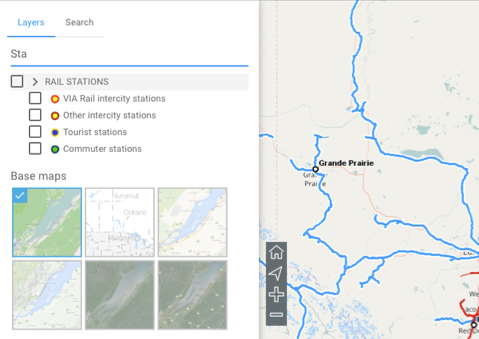
2.Click on  Sidebar to close the sidebar and display only the map.
Sidebar to close the sidebar and display only the map.
Layers
Layers contain information on various aspects of Canadian railways and on other related topics.
A layer can be made up of several different sets of data.
Layers can be organized hierarchically into groups in order to simplify work. Groups of layers are indicated in grey, and an arrow  is displayed next to the name of each group. To view the layers composing a group:
is displayed next to the name of each group. To view the layers composing a group:
1.Click on the arrow  next to the name of a group. Click on the arrows
next to the name of a group. Click on the arrows  to open the various subgroups of the hierarchy.
to open the various subgroups of the hierarchy.
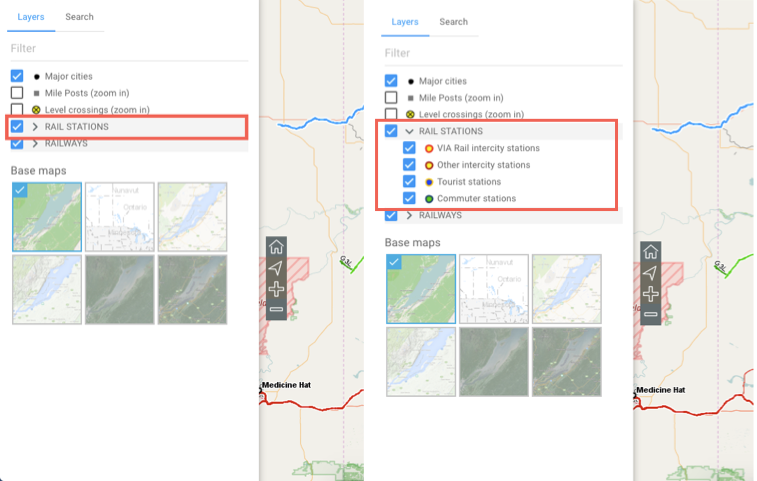
2.Click on the arrow  next to the name of a group to close it.
next to the name of a group to close it.
To view a layer:
1.Check the box located left of the name of the group and/or layer to display it in the map interface. When a group is selected, all the visible layers (whose check boxes are selected) will be displayed. When a group is unselected, none of the layers it contains or that are contained in subgroups will be displayed. Selecting or unselecting a group does not affect the visible/invisible state of the layers it contains. You can display several layers at the same time; the only restriction is the readability of the map.
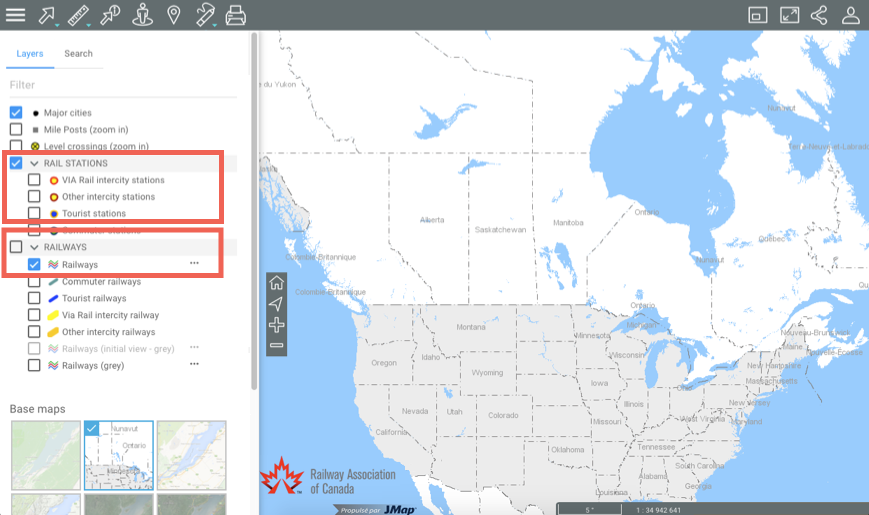
2.Unselect the check box to stop displaying the layer and/or group of layers.
Each layer is visible within a certain range of map scales. When the names and icons of layers are shown in lighter tones, this means the current map scale is outside of the visibility scale range of these layers. You can zoom in or out to find their visibility scale range.
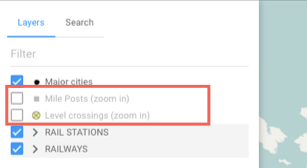
In the row of each layer, there are icons to access different functions. Some of the icons are displayed permanently, and others appear when the pointer is moved over them.
The arrow  allows you to make a layer selectable.
allows you to make a layer selectable.
1.Click on the arrow  . The arrow becomes blue
. The arrow becomes blue  , indicating that the layer's elements can be selected using the interactive selection tools. For more information on this topic, refer to Selecting Elements in the Map Interface.
, indicating that the layer's elements can be selected using the interactive selection tools. For more information on this topic, refer to Selecting Elements in the Map Interface.
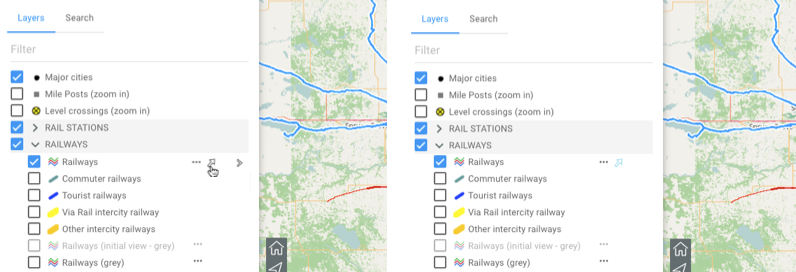
You can only select one layer at a time.
You can make each layer of a group independently selectable.
2.Click on the arrow  to make the data of the layer unselectable. The icon changes back to grey
to make the data of the layer unselectable. The icon changes back to grey  .
.
The  icon indicates that the layer has one or more thematics. When thematics are present, the appearance of the layer's elements will vary based on one or more attributes.
icon indicates that the layer has one or more thematics. When thematics are present, the appearance of the layer's elements will vary based on one or more attributes.
1.Click on the  icon to display the thematics.
icon to display the thematics.
2.Check the thematic you wish to display. The legend of the thematic is displayed, and the layer adopts the appearance of that thematic.

3.Unselect the thematic to disable it.
4.Click on the  icon to hide the thematic.
icon to hide the thematic.
The  arrow offers access to a function which brings the map to the layer's geographic extent.
arrow offers access to a function which brings the map to the layer's geographic extent.
1.Click on the arrow  . A magnifying glass
. A magnifying glass  appears.
appears.
2.Click on the magnifying glass  . The geographic extent of the data layer is displayed and centered in the map.
. The geographic extent of the data layer is displayed and centered in the map.
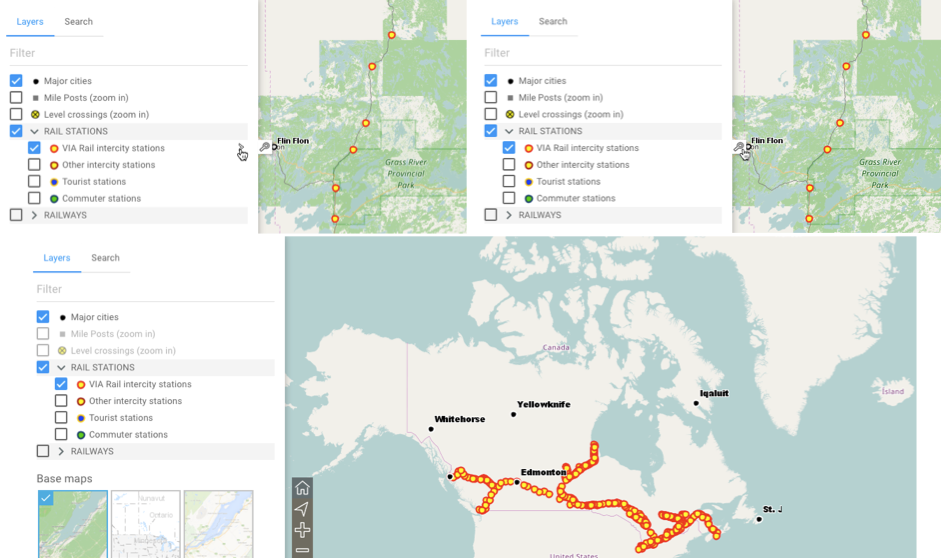
Base maps
Base maps serve as the background of the Atlas's map interface. They provide a context for the information contained in the layers. The Atlas offers a base map showing hydrography and territorial limits, created specifically for the RAC.
You can also access maps taken directly from Google Maps and OpenStreetMap. Google Maps offers four types of maps: Plan, Terrain, Satellite, and Hybrid.
You can only display one base map at a time. When you position the mouse pointer on the icon of a base map, its name is displayed.
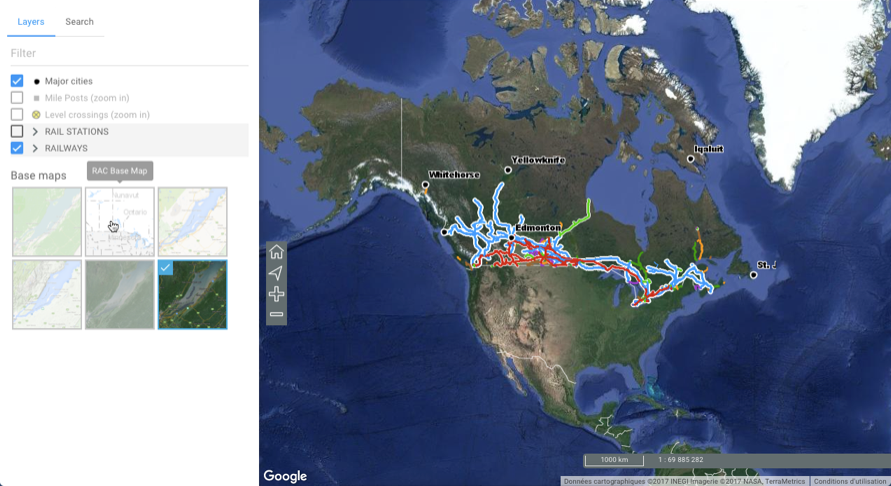
1.Click on the map of your choice to display it.